Time to invest in more long-term protection for Mirror Lake
- Mirror Lake is seen on April 16, 2023. (News photo — Andy Flynn)
- Mirror Lake in Lake Placid is seen on April 16, 2023. The toboggan chute, Olympic Center arenas, conference center, post office and Adirondack Community Church can be seen from this vantage point. (News photo — Andy Flynn)
- A beer can is seen on the bottom of Mirror Lake in Lake Placid, near the shoreline, on April 16, 2023. (News photo — Andy Flynn)
- Mirror Lake in Lake Placid is seen on April 16, 2023. (News photo — Andy Flynn)
- From left, Lisa Reid, Trish Friedlander and Anja Kola prepare to take off from the Lake Placid municipal beach in October 2021 as part of an annual pre-Halloween celebration. Every year, a group of women dress as witches and take to Mirror Lake to spread some Halloween cheer. Friedlander, Shelley Reynolds and their friends started this tradition in 2018. (News photo — Lauren Yates)
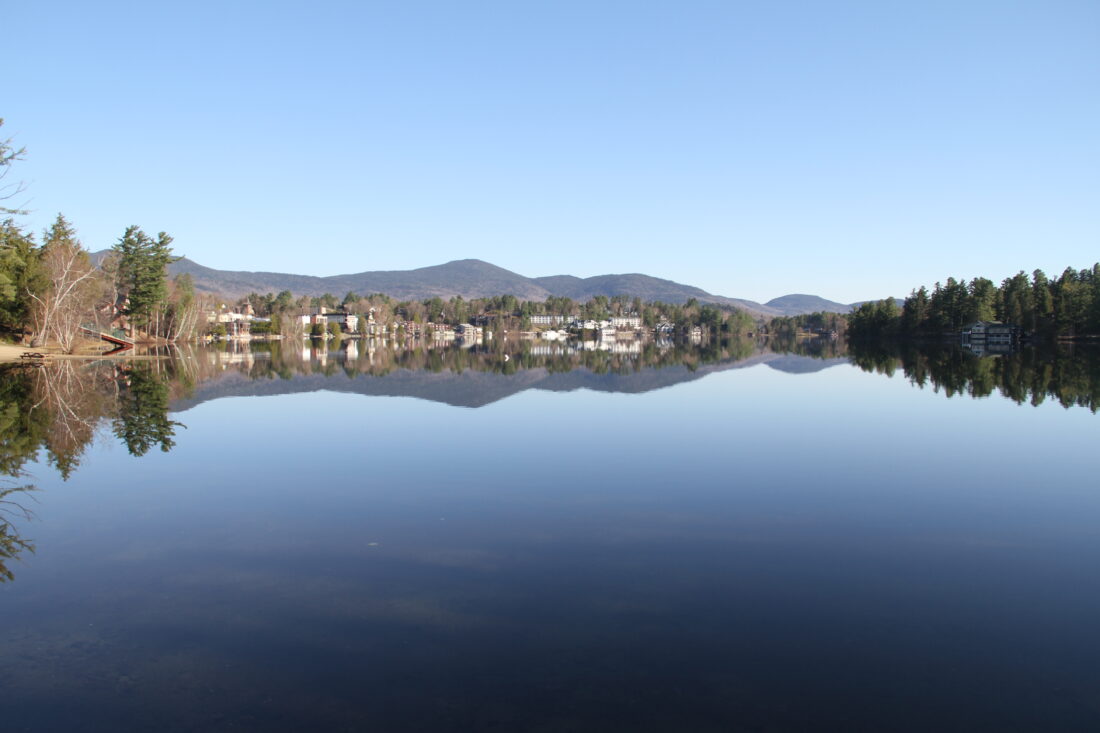
Mirror Lake is seen on April 16, 2023. (News photo — Andy Flynn)
Who should protect Mirror Lake, and who should pay for that protection?
Those are the main questions we’re asking this week.
The short answer is everyone — all the people who own the lake, own property around the lake, use the lake, make money directly and indirectly from the lake and love the lake, which is just about everyone who comes in contact with it.
We’re all stewards of Mirror Lake.
It isn’t just the government — the village of Lake Placid, town of North Elba or state of New York — that needs to invest time and money to keep Mirror Lake safe from pollutants, invasive species and other threats.

Mirror Lake in Lake Placid is seen on April 16, 2023. (News photo — Andy Flynn)
It certainly isn’t up to the volunteers at the Mirror Lake Watershed Association; they have no legal mandate under a municipal charter to be stewards of the lake. Yet they do it anyway. Their charter is personal, not written in a document. It comes from the heart. Their mandate comes down to two words: They care.
–
The crown jewel of Lake Placid
–
We were at Mirror Lake on Sunday morning, April 16, two days after the ice went out. It was one of those perfect spring mornings when Mirror Lake lived up to its name. With almost no wind, the lake water was indeed a mirror, reflecting everything around the shoreline: trees, parks and buildings, mostly.
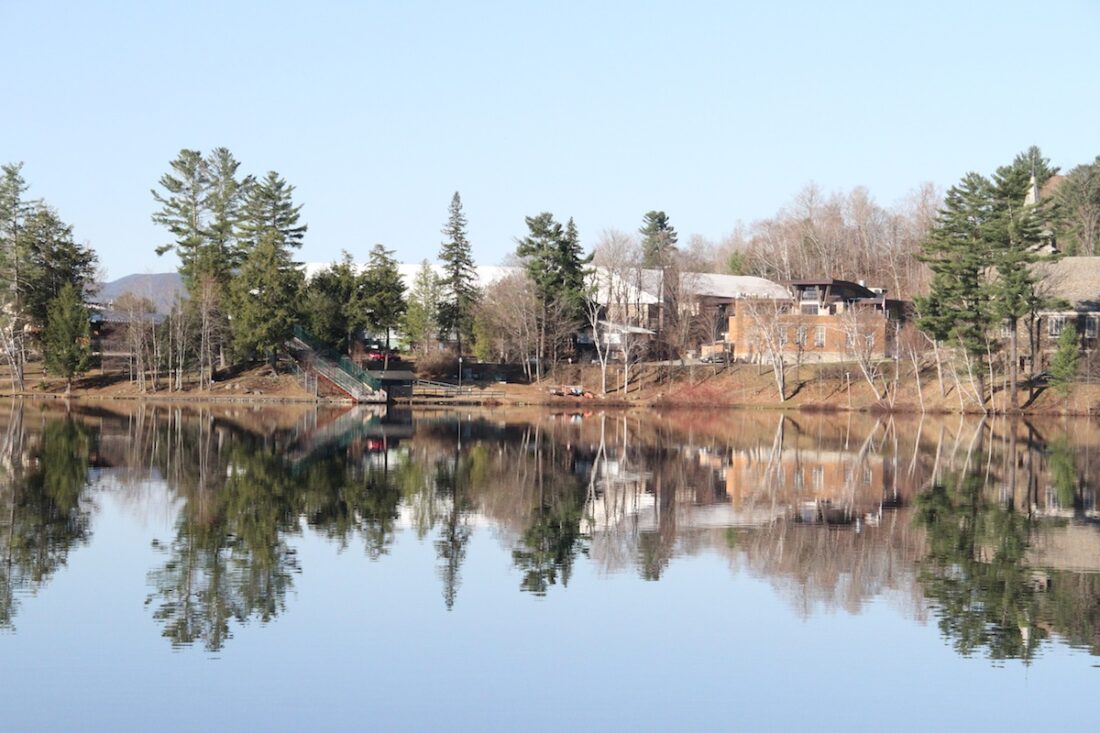
Mirror Lake in Lake Placid is seen on April 16, 2023. The toboggan chute, Olympic Center arenas, conference center, post office and Adirondack Community Church can be seen from this vantage point. (News photo — Andy Flynn)
We could see, in the water, many of the landmarks that make the village of Lake Placid so beloved: the Olympic Center’s 1932 and 1980 arenas, beach house, post office, conference center, Adirondack Community Church, toboggan chute, Mid’s Park, Brewster Park, Peacock Park and major hotels such as the Golden Arrow Lakeside Resort and Mirror Lake Inn.
Blended among the bird songs, babbling Mirror Lake outlet and the din of traffic were the sounds of life — people enjoying the lake — children playing in Peacock Park and men and women walking their dogs, drinking their morning coffee, jogging, bicycling, taking photos of the lake and ducks at the beach with their smartphones, and walking the 2.7-mile loop with family and friends.
On April 4, Mirror Lake Watershed Association board member Sandy Edgerton Bissell posed an important question to the North Elba Town Council. She was with MLWA co-chair Bill Billerman to ask for help in funding this year’s summer watershed steward program.
“Can you imagine the village and the town without a healthy lake?” she asked.
No, we can’t.
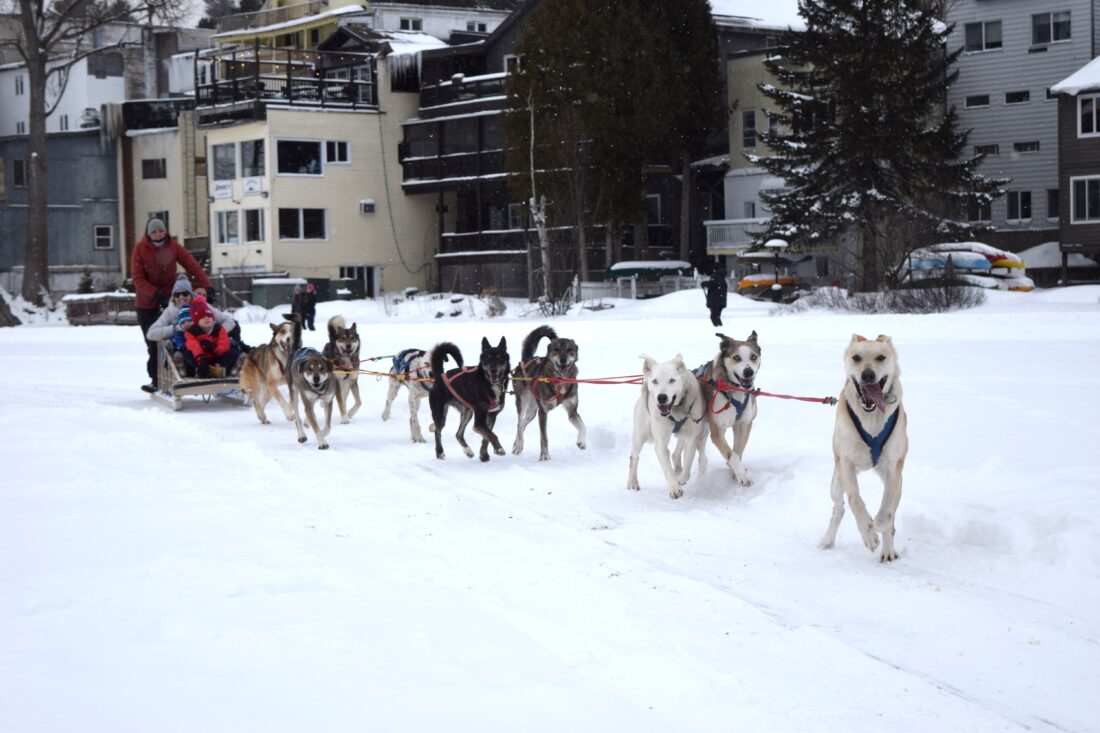
Thunder Mountain Dog Sled Tours employee Emma Houghton drives visitors around Mirror Lake in Lake Placid on March 4, 2022. (News photo — Lauren Yates)
Mirror Lake is in the heart of the village of Lake Placid. In the winter, it’s used for dogsledding, ice skating, pond hockey and tobogganing. In the summer, it’s a bustling community of recreationists, and it’s used for swimming, fishing, paddleboarding and boating.
It’s the location of the municipal beach, where — every July — it’s packed with more than 2,000 athletes swimming in the Ironman Lake Placid triathlon race.
Mid’s Park — sandwiched between Main Street and Mirror Lake, next to Eastern Mountain Sports — is a hub of social activity year-round. In the winter, it’s home to the village Christmas tree. In the summer, the Lake Placid Sinfonietta presents Wednesday evening concerts at the Paul White Memorial Band Shell and musicians from around the country perform Tuesday evenings in the Songs at Mirror Lake series. It is common for paddlers to watch those concerts from their boats on the lake.
On July 4 every year, crowds gather around Mirror Lake to watch the fireworks display while the local radio station “sets the night to music” in a choreographed extravaganza.
Simply put, Mirror Lake is integral to the economy and the social scene of Lake Placid. It adds immeasurably to the quality of life for residents, and it’s a magnet for visitors to make long-lasting memories.
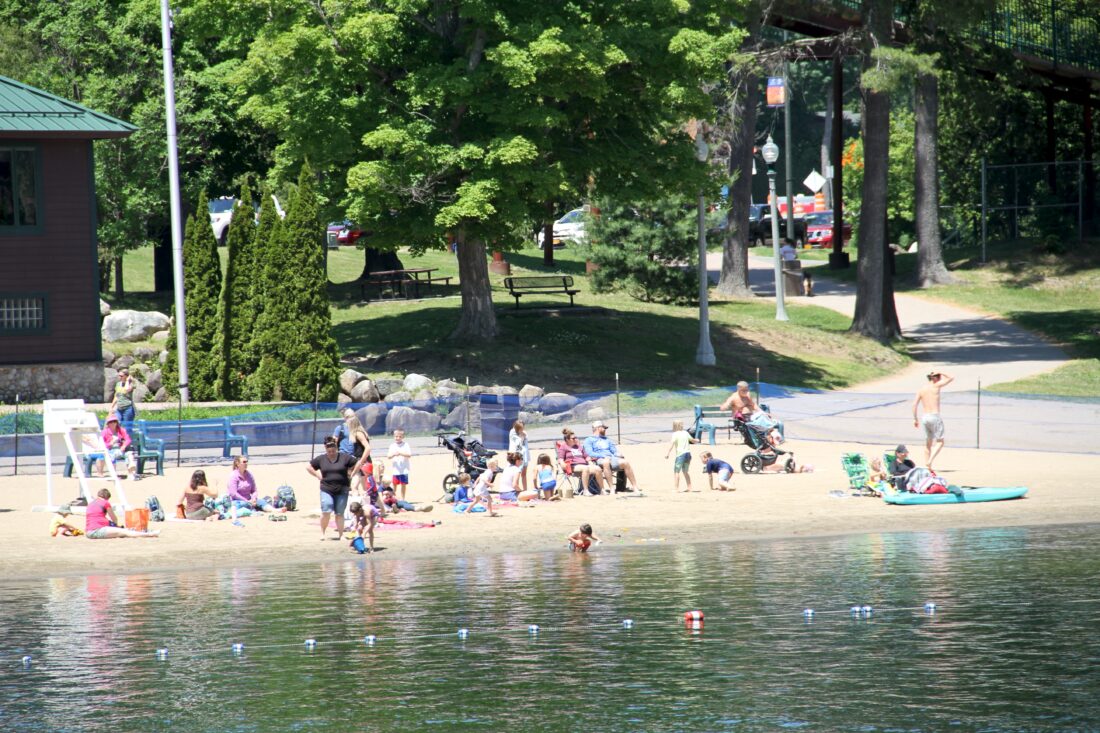
Families enjoy the municipal beach on Mirror Lake June 20, 2022. The beach opened on Saturday, June 18. (News photo — Andy Flynn)
–
Ongoing threats
–
On the surface, Mirror Lake — in all its beauty — seems perfectly healthy. Yet threats from human and animal activity — including pollution, road salt runoff and invasive species — are all too real. In 2020 and 2022, harmful algal blooms were recorded on Mirror Lake, and it was cause for alarm.
The MLWA website printed the following headline on Nov. 11, 2022, before explaining the harmful algal bloom: “BEWARE! AVOID CONTACT WITH MIRROR LAKE & DO NOT LET YOUR DOGS SWIM IN THE LAKE OR DRINK OUT OF THE LAKE.”

A sign, seen here Nov. 3, 2022, warns beach goers about harmful blue-green algae blooms on the shore of Mirror Lake. (News photo — Lauren Yates)
On Oct. 31, 2022, a harmful algal bloom of cyanobacteria (blue-green algae) was seen in Mirror Lake.
“It was widespread and still visible as of Nov. 2,” the MLWA reported. “Although it seems to have dissipated, the toxins can remain in the water for several days afterward, and exposure to the water by humans or pets could still cause serious, allergic reactions.”
Bissell’s question to the town reverberates when we think of HAB outbreaks and ominous warnings.
“Can you imagine the village and the town without a healthy lake?”
No, not when we’re asked to avoid contact with the lake in ALL CAPS.
The effects road salt in the winter have also harmed Mirror Lake. Last year was the first time since 2020 — and the second time in five years — that the lake had completely turned over in the spring. Saltwater is dense, settling at the bottom of the lake, and it can prevent mixing. Turnover is needed for fish since it distributes nutrients throughout the lake and replenishes oxygen.
Then there’s invasive species, both aquatic and terrestrial, which can “lead to the extinction of native plants and animals, destroy biodiversity, and permanently alter habitats,” according to the National Oceanic and Atmospheric Administration.
The Adirondack Watershed Institute (AWI) at Paul Smith’s College and the MLWA are trying to prevent invasive plants and animals from entering waterways — species such as Eurasian watermilfoil, variable-leaf watermilfoil, zebra mussels, hydrilla and spiny waterflea. It’s a lot cheaper than eradicating them once a lake is infested.
“Because it’s almost impossible to eradicate invasive species once they get in,” Billerman told the town.
Two invasive plants — purple loosestrife and the yellow iris — are already impacting Mirror Lake. With an “active infestation” of purple loosestrife around the entire lake, MLWA volunteers pull all those plants before they go to seed. Last summer, 258 purple loosestrife plants were removed.
And who knows, with climate change, unforeseen threats may be on the way. We need to be prepared.
–
Protection efforts
–
Let’s give credit where credit is due. A number of organizations have made progress in protecting Mirror Lake.
– Highway crews have worked hard to come up with road-treatment alternatives to reduce the amount of road salt runoff in the winter.
– Residents and businesses along the lake have reduced the salt they use for sidewalks and driveways.
– When the village of Lake Placid rebuilt its infrastructure along Main Street in 2021 and 2022, it included a new catch basin system to filter stormwater before it runs into Mirror Lake.
– AWI staffers continue to monitor the lake water daily and educate the public about environmental threats to the lake.
– Educational efforts come from groups such as the MLWA, Regional Office of Sustainable Tourism and Ausable River Association (AsRA).
– When you see the four interpretive signs that were erected around Mirror Lake in 2022, you see a regional effort to protect Mirror Lake. Located at Peacock Park, Mid’s Park, Brewster Park and the canoe carry trailhead on Mirror Lake Drive near the Lake Placid lake boat launch, the signs describe the lake’s ecosystem, challenges to it and protection efforts underway. They were made possible by the AsRA, Rensselaer Polytechnic Institute (RPI) and AWI, and they were produced with funds from the National Science Foundation through RPI and from the Lake Champlain Basin Program and NEIWPCC through AsRA.
– Last year, AWI Communications Fellow Stephanie Tyski created the self-guided Mirror Lake Watershed Walk for the PocketSights app, featuring 14 stops along the southwestern portion of the lake, starting at Brewster Park and ending near the beach.
– While not specific to Mirror Lake, the state Department of Environmental Conservation last summer enacted a new law during Invasive Species Week that affects anyone using a motorboat inside the 6-million-acre Adirondack Park, and within 10 miles of its boundary. Boaters must now carry a certificate showing their watercraft has been cleaned, drained and dried for every trip: “Cleaning, draining, and drying protects New York’s waters by reducing the possibility of aquatic invasive species being introduced into new waterbodies.” Certificates are not needed for canoes or kayaks, such as those on Mirror Lake; however, paddlers are required to clean, drain and dry their vessels and equipment. Yet motorboats are used during Ironman.
We thank all these organizations for their ongoing efforts to help protect Mirror Lake, especially the MLWA volunteers.
–
Long-term solutions
–
The Mirror Lake watershed steward program was launched in 2021, funded by a town of North Elba Local Enhancement and Advancement Fund (LEAF) grant. Goals for the program included educating the public about the impact of invasive species and collecting data on boaters — how many were using the lake and where they were coming from.
A steward spent two days a week from mid-June to late August, eight hours a day, at the public boat launch near the tennis courts — mostly for canoes and kayaks since gas-powered motorboats are not usually allowed — inspecting boats and educating their users about invasive species and “Clean, Drain, Dry” practices.
Last year, the program grew to four days a week, funded again by a LEAF grant, and stewards noticed an influx of boaters, which means more potential for spreading invasive species.
In 2022, the steward counted almost 1,200 boats entering the lake, and 53 had organisms on them, none of which were invasive species.
“But you could see that there is the potential — because of the invasive species that are in the lakes around us, such as Lake Flower and Lake Placid — that there is that possibility,” Billerman told the town.
This year, MLWA board members want to expand the program to seven days a week — eight hours a day from mid-June to Labor Day. A LEAF grant was denied, so they are trying to get money from the village and town and other grant programs to cover the $26,000 cost.
When does the protection of Mirror Lake end?
Never. We’re in it for the long haul. Threats from pollution, HABs and invasive species will always be here, and it will take an ongoing investment to protect the lake.
That’s why, when the MLWA raises the $26,000 needed to fund this year’s watershed steward — a program administered by the AWI — it will be time to create an annual funding solution for the program.
Billerman and the rest of the MLWA team already have some ideas. They’ve asked the village and town to put money in their annual budgets to help fund the program. They also plan to ask the Ironman corporation for money.
Ironman should help, and the contribution should be substantial. After all, without a healthy Mirror Lake, they wouldn’t be here. People train on Mirror Lake because of the race, and the swim portion makes up one-third of the competition. Mirror Lake isn’t just important to Ironman Lake Placid; it’s necessary.
The MLWA could also set up a fund for the Mirror Lake watershed steward program through the Adirondack Foundation, similar to the one that helps protect Lake Placid lake. It’s called the Keep Placid Pure Fund:
“This Fund shall be used exclusively for programs and services needed to maintain the highest water quality, prevent and control invasive species, and maintain the health and safety of the lake and shoreline.”
–
Get involved and give today
–
We urge the village, town and Ironman to begin making annual contributions to the Mirror Lake watershed steward program.
We encourage the MLWA to work with the Adirondack Foundation to create a fund for long-term environmental protection and to continue searching for grants that will help them achieve their goals.
We urge business owners and land owners around the lake, full-time and seasonal residents, and visitors to donate money to the MLWA for their protection efforts; there’s a PayPal donation button on their website — www.mirrorlake.net. Or you could write them a check to the MLWA, PO Box 1300, Lake Placid, NY 12946. Since the MLWA is a 501(c)(3) nonprofit organization, your donation is tax deductible. If you want your money to go specifically for the watershed steward program — or any protection effort — tell them. Donations are also used to help protect Mill Pond, which is part of the AuSable River watershed.
There is plenty of money in Lake Placid, and there are plenty of people who care. Let’s pool our resources and get this done.
Like Billerman said in a letter to village Mayor Art Devlin and town Supervisor Derek Doty, “We should all be invested in the preservation of the lake.”
Times are tough, and inflation is making lives harder for many families. If you can’t afford to donate money, you may be able to donate some of your time by volunteering for the MLWA. Monthly meetings are held at 5 p.m. every second Monday of the month at the beach house on Parkside Drive.
As the MLWA states on its website: “The cost to do all these projects is both human and monetary. Come to the meetings, offer suggestions, and give support. These meetings are open to public, and we encourage you to join us.”
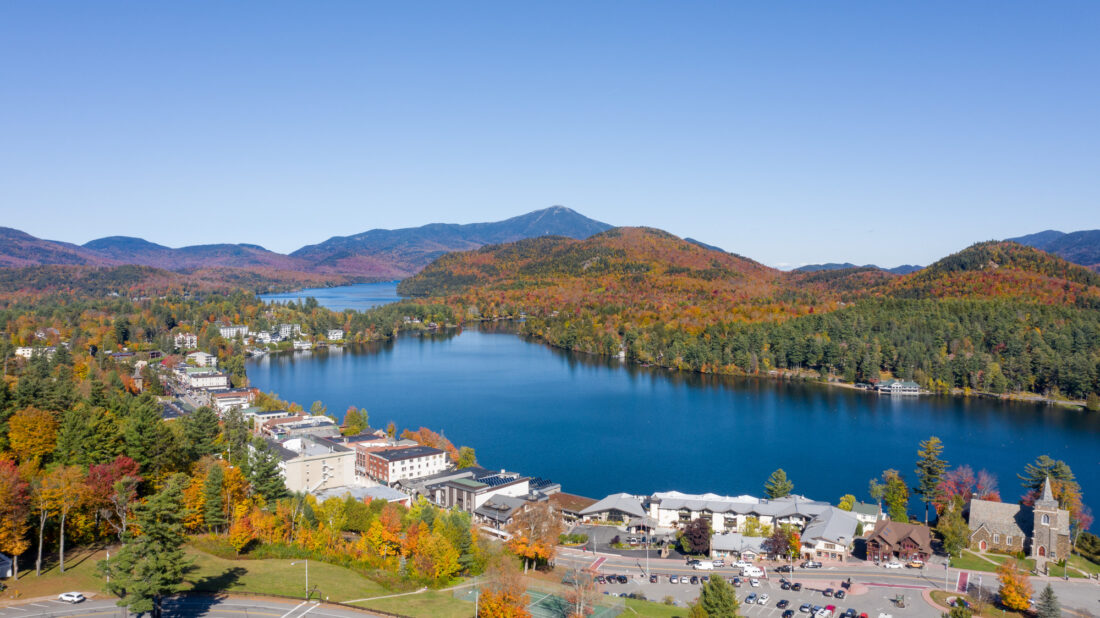
Mirror Lake, village of Lake Placid (Photo courtesy of ROOST)
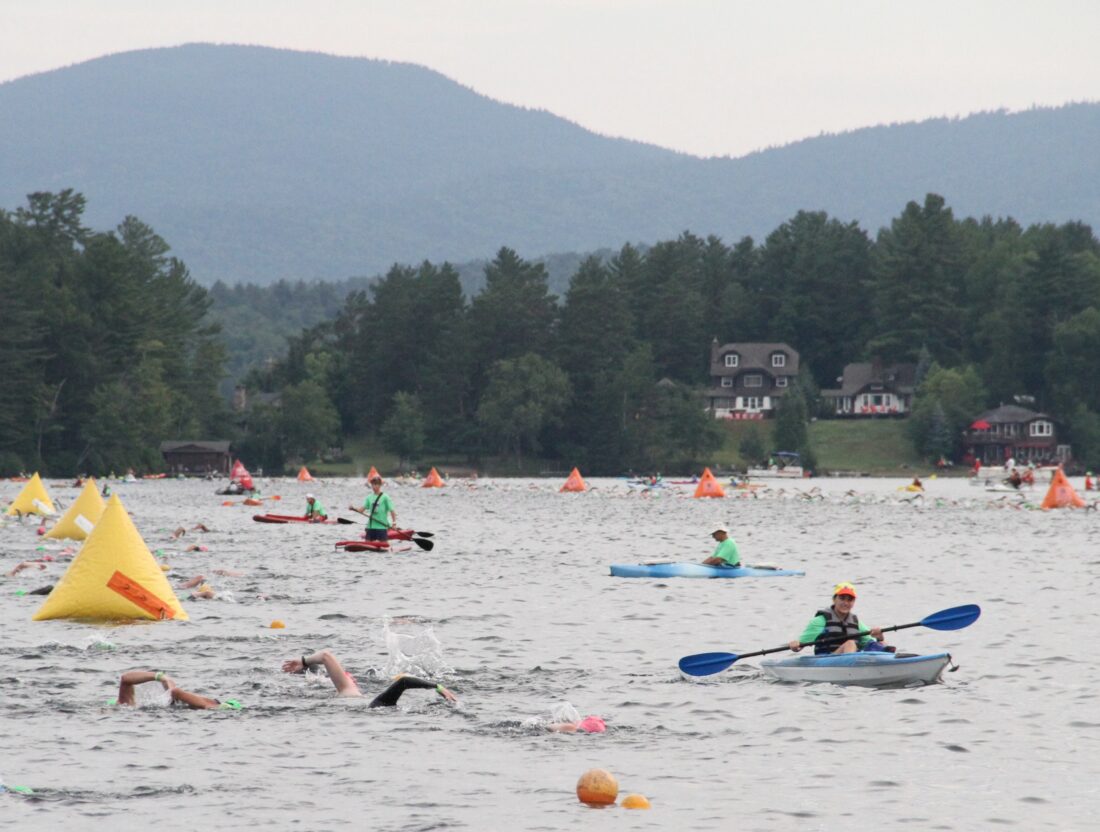
Athletes participate in the swim portion of the 2022 Ironman Lake Placid triathlon on Mirror Lake. (News photo — Andy Flynn)

Leanna Thalmann of the Ausable River Association and Lija Treibergs of the Adirondack Watershed Institute sample Mirror Lake at the continuous monitoring buoy. (Photo provided — Alice Dong)
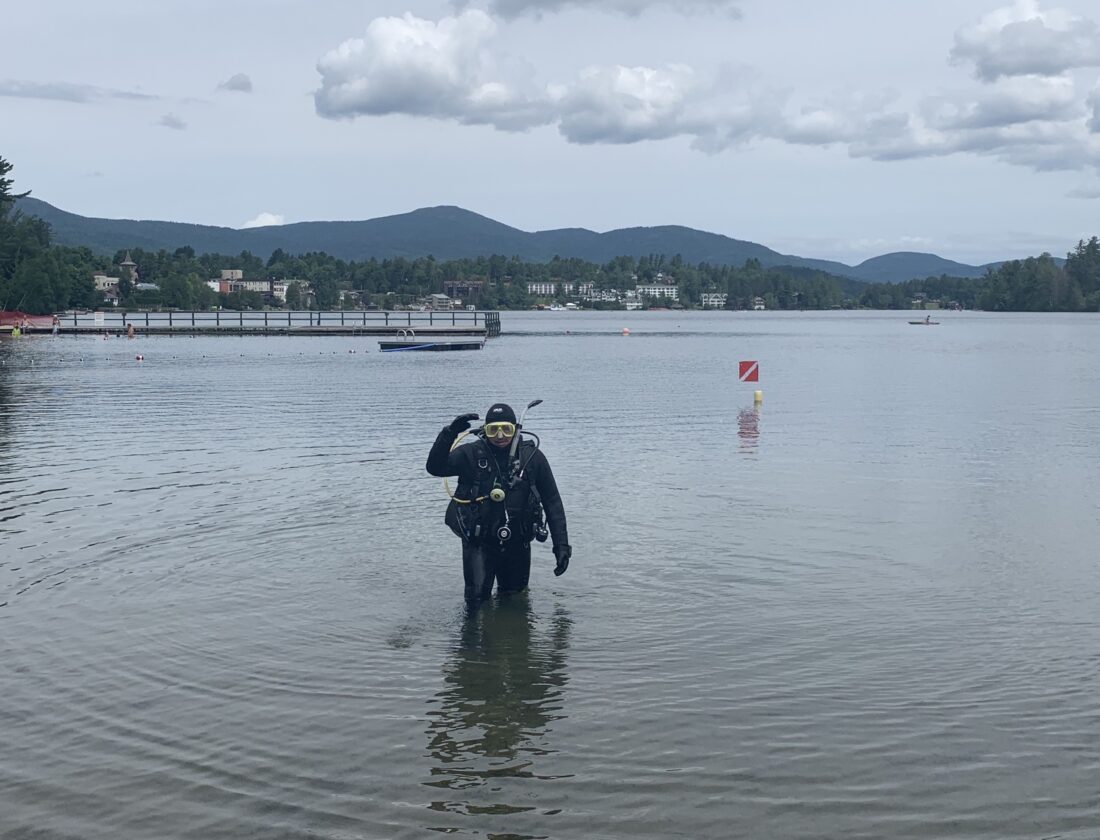
Larry Jacques is one of the divers who helped clean up Mirror Lake in July 2021. (Provided photo — Sandy E. Bissell)
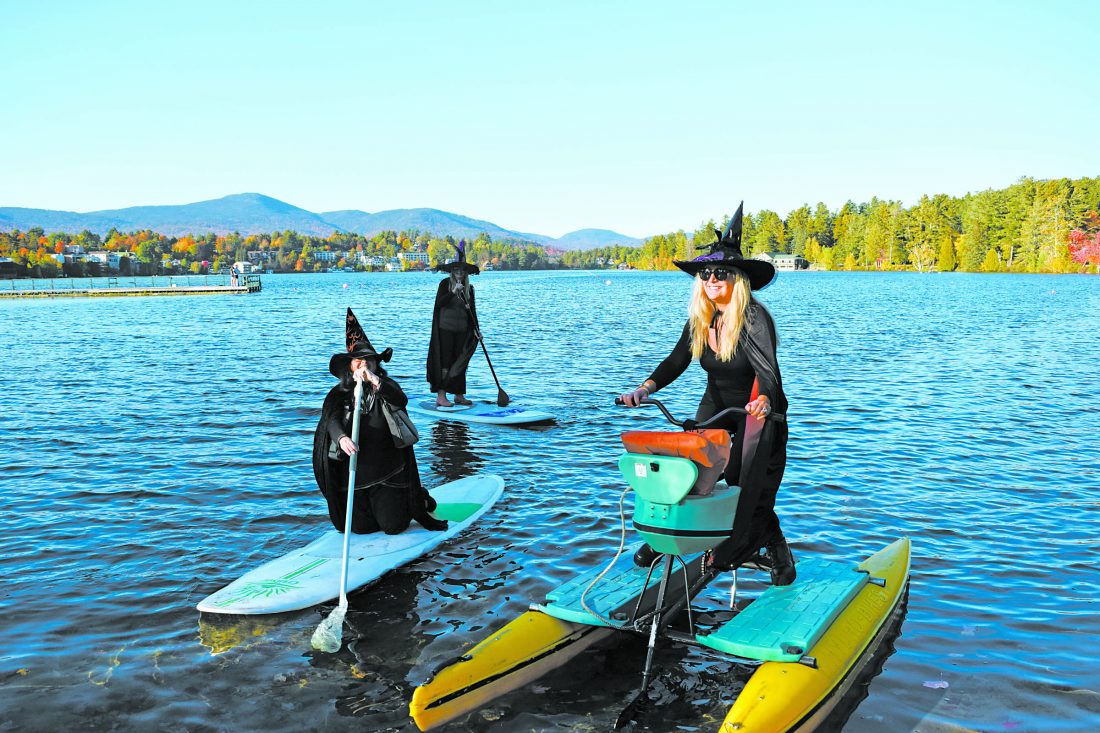
From left, Lisa Reid, Trish Friedlander and Anja Kola prepare to take off from the Lake Placid municipal beach in October 2021 as part of an annual pre-Halloween celebration. Every year, a group of women dress as witches and take to Mirror Lake to spread some Halloween cheer. Friedlander, Shelley Reynolds and their friends started this tradition in 2018. (News photo — Lauren Yates)

Workers hoisted the tractor out of the ice on Jan. 31, 2021, using inflatable pontoons and a makeshift frame on Mirror Lake, Lake Placid. (Provided photo — Alex Madden)

